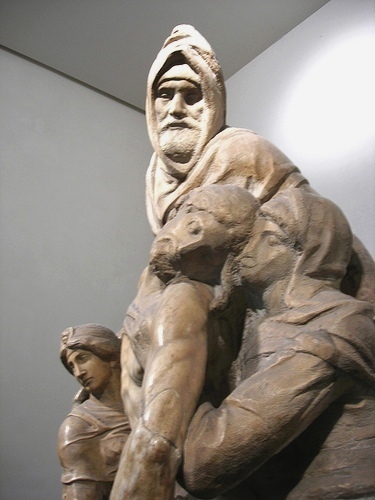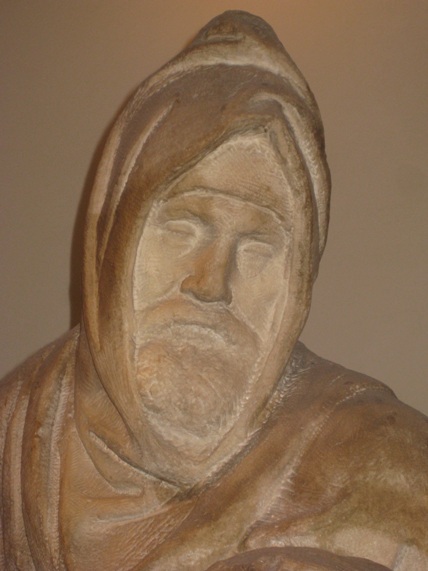Michelangelo and Nicodemism the Florentine Pietãƒâ ã¢ââ the Art Bulletin
Fine art and the Church -> Materials for Use in Churches
Good Fri - Florence Pieta by Michelangelo
Michelangelo'due south Florence Pietà

A Personal Pietà
by Nigel Halliday
This is ane of the most personal and poignant sculptures I know. It was a kind of retirement project for Michelangelo, who intended it to stand over his own grave.
Afterwards 1545, when he was 70 years old, Michelangelo accepted no further commissions for painting or sculpture, although he was still decorated with various architectural commissions such as St Peter's and the Capitoline Colina in Rome. Nevertheless, he continued to sculpt every day until only a week or so earlier his death in 1564. And then we tin imagine him in these years around 1547 to 1555 working on this piece, scrap by flake, daily shaping its form.
He abased the work in 1555 for reasons that are unclear and another sculptor worked on parts of information technology, especially the female figure on the left. Nevertheless, there is more than plenty here to prove us Michelangelo's intent, especially in the effigy of Nicodemus, who stands over the group and enfolds them, bearing Michelangelo's distinctive self-portrait.
The limerick is unusual. It is known as a Pietà, but that normally involves but Mary the mother of Jesus mourning over the body of her son, although sometimes she is assisted past another effigy, such as Mary Magdalene. The figure of Nicodemus is unremarkably restricted to images of the Deposition, equally we know that he assisted Joseph of Arimathea in taking down Jesus' torso from the cross (John 19:39). By introducing Nicodemus into a Pietà and imposing his own features on the figure, the creative person is clearly making a point of his ain personal identification with the Lord's sacrifice.
With his extraordinary grasp of iii-dimensionality Michelangelo gives usa different insights into the scene. From the front Nicodemus stands alpine, not in whatever fashion competing with or imposing himself into Mary'due south closeness to Jesus. He has helped to take downwards the torso. Now he is doing what he can to take the weight of the trunk, while continuing in silent unity with the two Maries. But from the side, as the heads align into a very narrow triangle, one senses a much greater personal closeness of the creative person to the Lord.

Since the 1530s Michelangelo had been involved in a Protestant-inspired Bible report grouping that met in one case a calendar week to read and discuss the Bible. From this time his poetry shows a sudden and profound grasp of salvation past grace, not past works. Sadly, with the Counter-Reformation beginning in the 1540s all the other members of the group were persecuted or driven into exile. Then in 1547 one of Michelangelo's dearest friends, Vittoria Colonna, who had been forced to recant nether threat of torture, had died. Perhaps it was this loss that inspired him shortly later to start work on this Pietà.
Fifty-fifty though Pope Paul IV robbed Michelangelo in 1555 of his pension, he was spared persecution, presumably considering of his fame and the importance of his work in the Vatican. Nonetheless, his sympathies were known. When in 1549 a re-create of his Pietà from St Peter's was installed in the church of Santo Spirito in Florence, an anonymous letter of the alphabet was circulated which described him as 'a respecter of art only non of devotion' and described the piece of work as a 'Lutheran caprice'.
Certainly, in The Florence Pietà at that place is an accent on the deadness of Christ's body, feature of Protestant art. In the Renaissance, and then heavily influenced by Platonism, there had been a reluctance to engage with the reality of God himself suffering the horrors of the cross. Some works, for instance, prove Jesus as if he were comatose rather than dead, showing scarcely any signs of physical damage.
With the Reformation's emphasis on salvation by God's grace, the notion that Jesus truly died on the cross in our place returns to the theological heart. This is the emphasis nosotros see in this work. The effigy of Christ is unusually awkward and emphatically dead. And Michelangelo looks downward over this fallen figure with pitiful and tranquillity reflection.

But he looks from within the hood of Nicodemus. Many Christians have come to regard Nicodemus equally a chip of a coward for coming to Jesus by night (John 3), presumably considering he was agape of his boyfriend Jewish leaders. However, Italian Protestants of Michelangelo'due south day were much more sympathetic to his predicament. For they knew that, if they publicly aligned themselves with Protestant doctrine, information technology would hateful persecution and expiry. Michelangelo identifies himself with Nicodemus, an old man who has grappled with Jesus' statement that he needs to be born again and who now clings in religion to the crucified Jesus through whom solitary that new life tin can come up.
It would have been a great piece of work of funerary sculpture – full of humility, faith and hope!
*******
Michelangelo: The Florence Pietà , 1547 – 1555, Museo dell'Opera del Duomo, Florence, Italia.
Michelangelo Buonarroti (1475-1564) was an Italian Renaissance sculptor, painter, architect and poet. He is generally considered ane of the greatest artists ever. He worked in Florence and Rome. As a student in the household of Lorenzo de' Medici Michelangelo met some of the greatest thinkers and artists of his days. In 1496 he moved to Rome, where ane of his first major assignments was the at present well-known Pietà in St Peter'south Basilica. Dorsum in Florence Michelangelo created several other masterpieces, including the David (1501-1504). Pope Julius 2 commissioned him to decorate the ceiling in the Sistine Chapel (1508-12). The frescoes describe prophets, sibyls and scenes from Genesis, translating from sculpture into painting Michelangelo's preference for potent, muscular figures. He returned to the Sistine Chapel in 1536 to brainstorm the huge Final Judgment on the altar wall, finishing the work in 1541. In 1547 he was unwillingly put in charge of the rebuilding of St Peter's, and had a decisive influence over its final design. Michelangelo died in Rome in 1564. He is buried in the church building of Santa Croce in Florence.
Nigel Halliday is a freelance teacher and writer in the history of art, and i of the leaders of Promise Church building, Greatham, in the Great britain. www.nigelhalliday.org
ArtWay Visual meditation Jan 20, 2013
Source: https://www.artway.eu/content.php?id=1284&lang=en&action=show
0 Response to "Michelangelo and Nicodemism the Florentine Pietãƒâ ã¢ââ the Art Bulletin"
Post a Comment